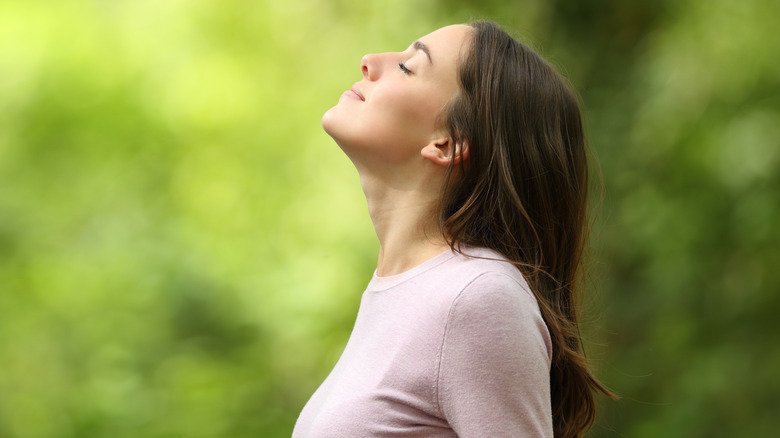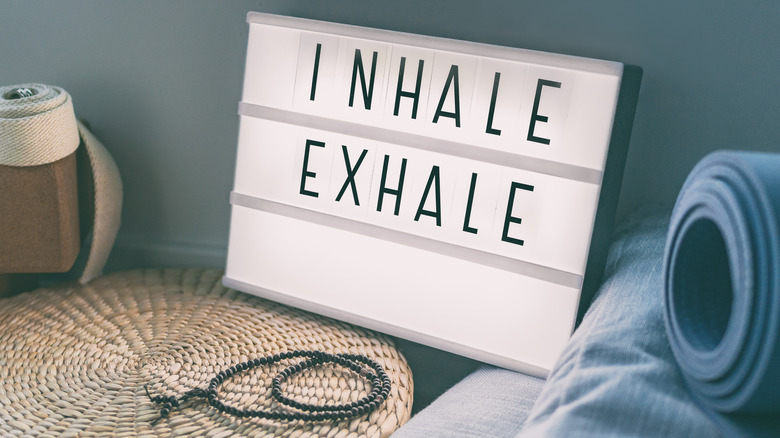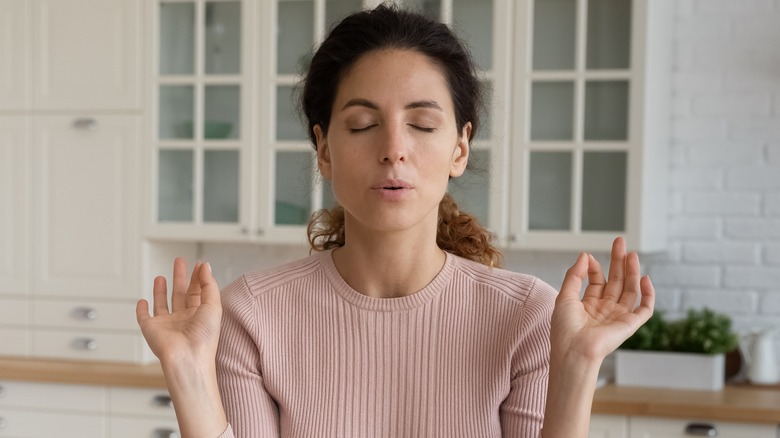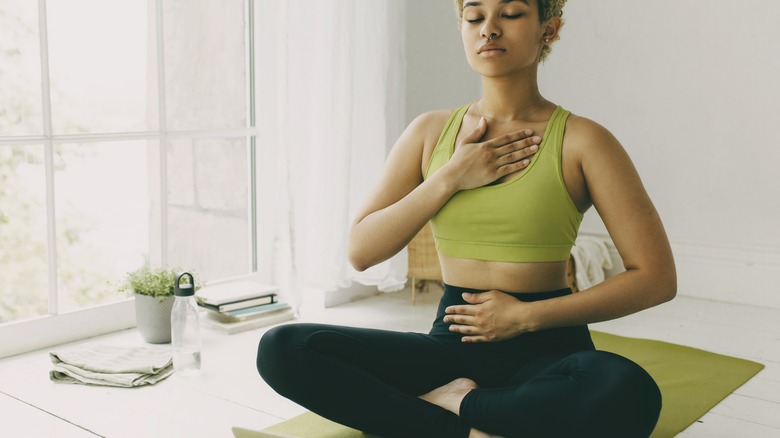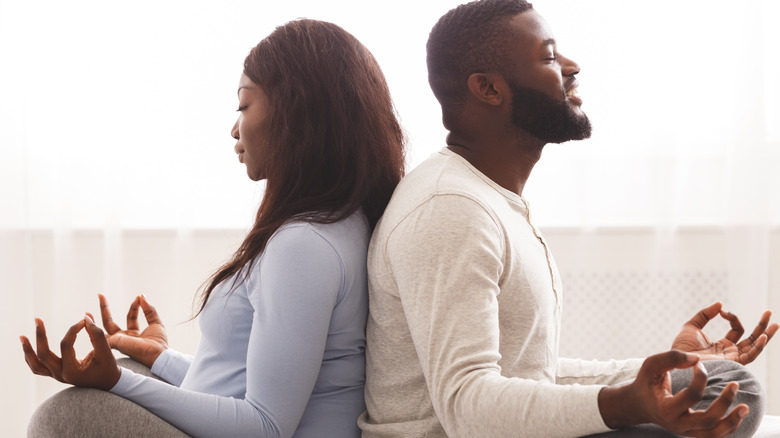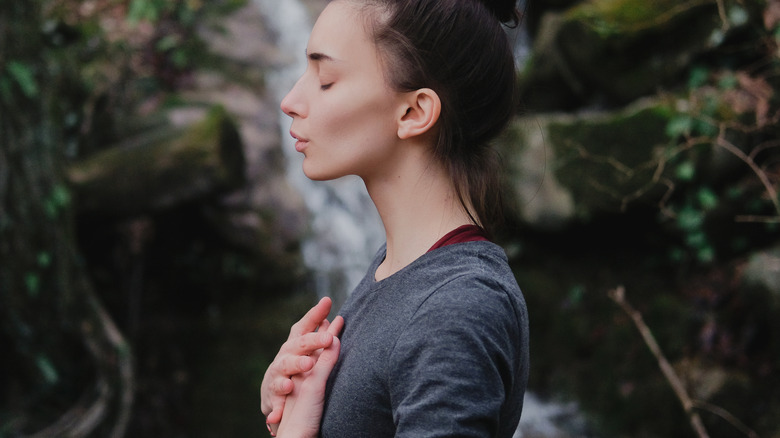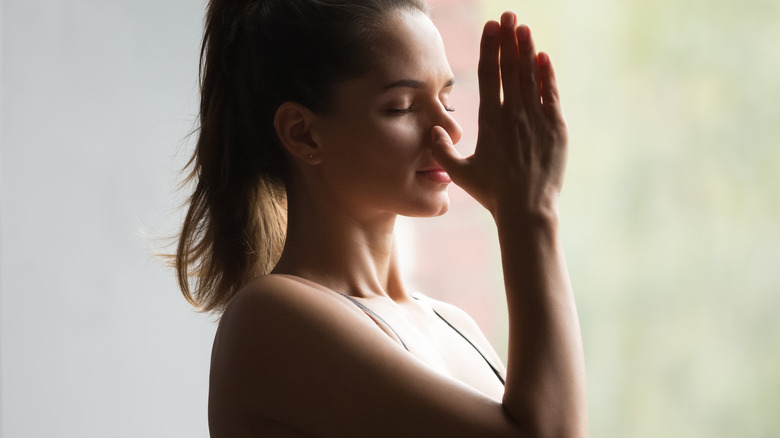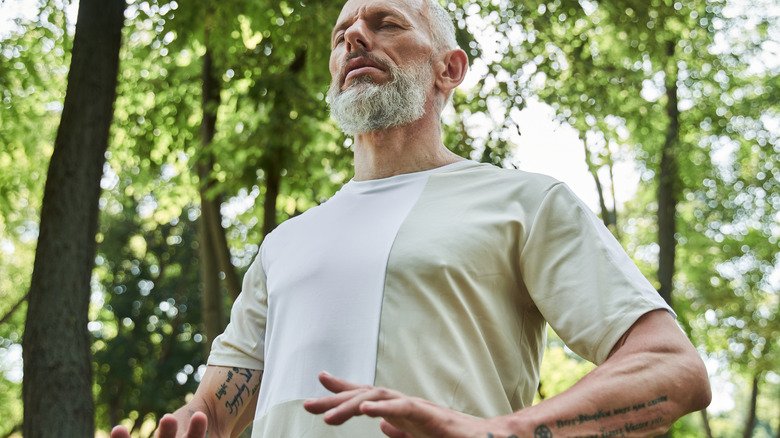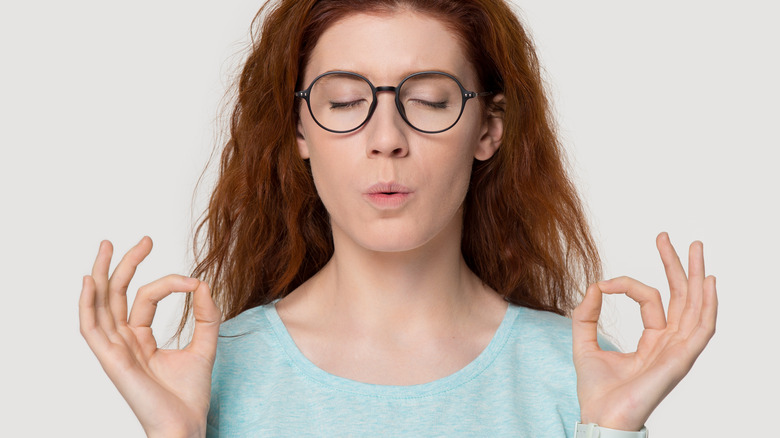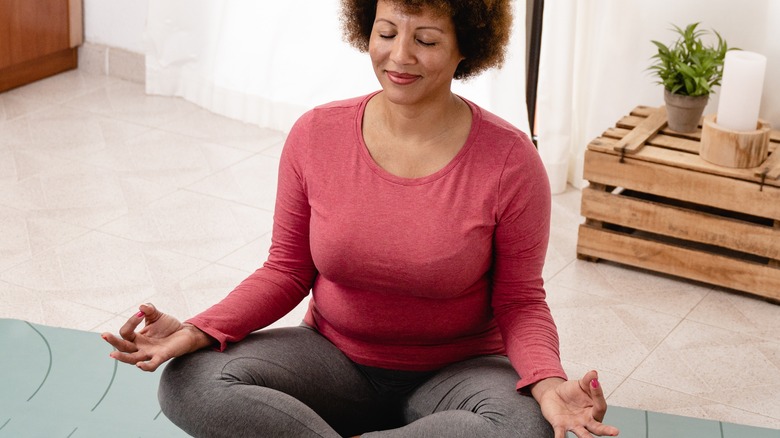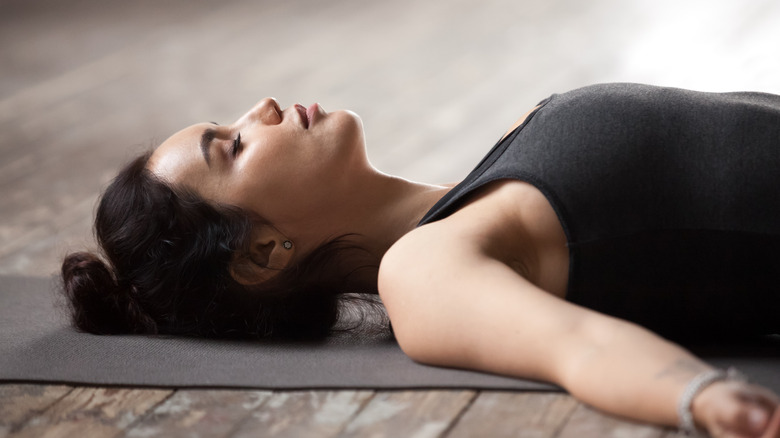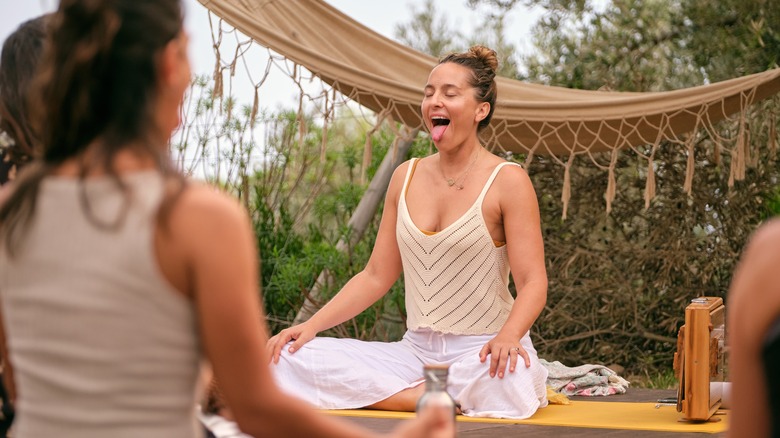11 Breathing Exercises That Help Quell Anxiety
Breathing is an involuntary action that supplies our bodies with fresh oxygen and flushes out carbon dioxide (via Breathe). We often pay very little attention to this automatic process. But it can also be controlled voluntarily to help regulate our mood and emotions, via a 2020 review in Medicines (Basel). Improper breathing, on the other hand, can throw our bodies off balance in all kinds of ways, according to PainScience.com. It can cause and exacerbate stress, headaches, body pain, and various emotional issues.
There are many powerful breathing exercises that can be used to help release tension stored in the body (via a 2018 paper in Frontiers in Human Neuroscience). Breathing activates your vagus nerve, which plays a key role in regulating your parasympathetic nervous system (via Breathe). This slows down bodily functions like heart rate and circulation. Taking deeper, more intentional breaths, in particular, can dial down anxiety by stimulating vagal activation of GABA pathways in the brain (per Medicines (Basel)).
Here are some science-backed breathing exercises that can help prevent and fend off anxiety.
The effects of shallow breathing
Most of us have been conditioned to take shallow breaths, or to breathe with our upper chest (via Headspace). We tend to inhale quickly through the mouth, take in a small amount of air, and hold our breath without realizing. But we weren't born to breathe this way –- we develop this habit over time. Proper breathing, on the other hand, should be deep, expanding the belly and filling the lungs.
We may not realize it, but shallow breathing keeps us locked in a cycle of anxiety. Our body's built-in fight-or-flight system means that we're designed to take quick, small breaths when we're feeling stressed out: Our muscles tighten and our heartbeat quickens, priming us for action. This naturally causes us to hold our breath. By the same token, shallow breathing induces feelings of stress, reducing the flow of oxygen-rich blood to your brain.
Shallow breathing has a number of negative physiological and psychological effects, per an article in the Journal of Neuroscience. It can cause panic attacks, impair your memory, and slow down your cognitive processes. Research shows that it brings down the number of lymphocytes in your body (via Headspace). This is a type of white blood cell that helps your immune system fight infections and viruses. In other words, people who take short, superficial breaths might be more vulnerable to diseases than those who breathe deeply.
Slow breathing
There are many different forms of slow breathing exercises, all of which have the potential to reduce stress and anxiety by acting on the autonomic nervous system (via a 2017 article in Breathe). When breathing normally, humans generally take between 10 and 20 breaths per minute. A slow breathing technique is defined as any exercise that lowers your breathing rate to somewhere between four and 10 breaths a minute.
There are lots of positive psychophysiological effects of slow breathing, according to research published in Frontiers in Human Neuroscience. Slowing down your breath is a very simple way to change gears and shift your body and mind into a deeply relaxed state. There's evidence that slow, deep breathing can help lift stress and anxiety in older adults, making way for more peaceful aging (via Scientific Reports). From a biological standpoint, drawing a protracted breath sends a signal to your brain that you're safe. Your pulse slows down and your heart beat decelerates, making you feel more at ease.
Diaphragmatic breathing
Diaphragmatic breathing, sometimes called abdominal breathing, is a popular technique that's known for its anxiety-relieving effects, per an article in Medicines (Basel). It's been used to improve the respiratory capacities of patients with chronic obstructive pulmonary disease (COPD), a condition in which air gets trapped in the lungs, causing diaphragm muscle weakness. It involves taking slow, deep breaths through the nose, both inhaling and exhaling for six seconds. Your chest should remain still while your stomach expands as you actively engage the diaphragm.
Each time you breathe in, the diaphragm contracts and moves down toward your abdomen, per Harvard Health Publishing. And with every exhalation, it relaxes and moves upward, helping your abdomen to push air out of the lungs. This type of breathing allows for an efficient exchange of oxygen and carbon dioxide in the body. It stimulates parasympathetic nervous system activity, slowing down your heart beat and lowering or stabilizing your blood pressure.
A study published in Perspectives in Psychiatric Care found that diaphragmatic breathing, when practiced over 8 weeks, helped bring down anxiety in patients in clinical and community settings. Although more research is needed, some studies suggest that diaphragmatic breathing can also treat stress, anxiety disorders, eating disorders, hypertension, and migraines, as well as improving quality of life in people with cancer and gastroesophageal reflux disease. Breathing from the diaphragm may be beneficial for the brain, as well as the body's cardiovascular, gastrointestinal, and respiratory systems.
Yogic breathing
Yogic breathing, also known as Pranayama, is one of the main components of yoga, according to an article in Frontiers in Psychology. The ancient yogis of India discovered that controlling the breath could induce profound relaxation. Over the years, researchers have found that yogic breathing has various mental and physical health benefits, including getting rid of anxiety, tension, and anger.
Most pranayamic breathing techniques reset the autonomic nervous system, shifting it toward parasympathetic dominance, notes a 2020 study published in the International Journal of Yoga. In other words, they slow down your heart rate and lower your blood pressure. This can help regulate physiological arousal and stress, producing feelings of calmness and alertness.
Research shows that both fast and slow pranayama can alleviate stress, even though they may create different physiological responses (via International Journal of Yoga). Pranava is a type of slow pranayama that involves taking deep and rhythmic breaths. Practitioners are instructed to exhale two or three times longer than they inhale, while making the sounds AAA, UUU and MMM. And then there's Kapalabhati Pranayama, which is an energizing technique. With this technique, you're instructed to stick out your tongue and pant like a dog while sitting on the ground with your palms down and fingers pointed forward. You breathe in and out rapidly for 10 to 15 rounds, and this is repeated for three cycles.
4-7-8 breathing
Based on ancient yogic breathing practices, 4-7-8 breathing was designed to soothe the body and mind (via research published in the International Journal of Health Sciences and Research). This potent technique has been shown to promote relaxation and curtail anxiety. It has sleep-inducing effects and could be used as a natural alternative to sleep medications to help lull you into slumber, per the Alaska Sleep Clinic.
You can practice this technique while lying down, but it's best to learn it in a seated position with your back straight, notes DrWeil.com. Start by placing the tip of your tongue behind your upper front teeth, and keep it there for the duration of the exercise. Exhale through your mouth around your tongue, making a "whoosh" sound as you empty your lungs. Then inhale through your nose for four counts. Hold your breath for seven counts. Then, breathe out through your mouth again (and around your tongue) for eight counts. You can repeat this pattern three times.
The 4-7-8 breathing method helps calm down your whole system by increasing the relaxing neurotransmitter GABA in your brain (via the International Journal of Health Sciences and Research). This, in turn, reduces cortisol, your body's primary stress hormone. A slow, prolonged exhalation also helps saturate the blood with oxygen and remove more carbon dioxide from the lungs than normal.
Mindful breathing
Mindful breathing has been shown to bring down pain, stress levels, and negative thoughts (via a 2016 paper in PLOS One). It can even help eradicate anxiety and depression, according to some studies.
Mindfulness teaches participants to pay attention to their internal experiences, such as breathing, emotions, thoughts, and physical sensations. The goal is to observe these experiences objectively, without judgment. Learning to breathe in this way entails noticing and accepting the breath, whatever pace or depth it may be. This can help improve our ability to emotionally regulate, and to calmly handle unpleasant and challenging experiences.
Mindful breathing can effectively treat anxiety when used alongside cognitive reappraisal practices (namely, the reframing of negative thoughts). People who incorporated a mindful breathing practice into their daily routine had more positive automatic thoughts and less anxious ones than others. This had a knock-on effect on their emotions. As little as three mindfulness training sessions per week were enough to relieve some of the anxiety and stress that people were grappling with.
Alternate-nostril breathing
Alternate-nostril breathing, also known as nadi shodhana, can help dissipate anxiety. It does this by putting the brakes on sympathetic nervous system activity. A 2017 study found that 15 minutes of alternate nostril yoga breathing could improve attention and vigilance in participants by lowering their blood pressure and helping them feel calmer (via Medical Science Monitor Basic Research). Not only does the method reduce stress, but it can also help people make faster decisions and maintain high performance levels in the workplace.
To practice this anxiety-relieving technique, use your thumb and ring finger to block off one nostril at a time as you breathe through the other (via the Journal of Clinical and Diagnostic Research). Starting with your right nostril covered, exhale slowly and completely through the left nostril. Once you've completed this exhalation, close the left nostril with your ring finger, and take a slow, deep breath through the right nostril. Repeat this pattern two more times, alternating between nostrils, and notice your heart rate slowly fall. It's best to do this exercise in a seated position so that you can keep a straight posture.
Box breathing
Sometimes referred to as "four-square breathing," box breathing is a fun and easy technique that can help settle your nerves if you're feeling on edge (via StatPearls). The name alludes to the fact that you may picture yourself breathing in the shape of a box — that is, inhaling and exhaling at the same pace and duration. First, breathe out to a count of four. Hold your breath for four counts. Inhale to the count of four. Hold your breath for another four counts. And then exhale for four, starting again from the top. It may help to keep your eyes closed during the exercise.
Box breathing is a potent stress-reliever, according to a 2021 study from the Journal of Pharmaceutical Research International. Researchers found that people who practiced this method each morning and evening for 30 days had a better mood and lung function than others. This is because box breathing allows carbon dioxide to build up in the blood. This stimulates parasympathetic activation and acts as a natural sedative for the nervous system. Its calming effects may even help some postnatal mothers manage pain after labor, notes a 2021 study (via the Indian Journal of Continuing Nursing Education).
Pursed lip breathing
Pursed lip breathing is often used by people with asthma, chronic obstructive pulmonary disease (COPD), and other lung diseases (via StatPearls). This simple technique can help manage shortness of breath, as it gives people greater control over their breathing. It opens up the airways and clears out volatile acids like carbon dioxide, which can often build up in the blood of people with COPD, a condition known as hypercapnia. Pursed lip breathing can also help alleviate anxiety and bring about immediate feelings of relaxation.
The pursed lip technique is practiced by first inhaling through the nose, and then exhaling through the mouth for double the duration. After inhaling, you should pucker your lips (as though you're giving a kiss) and slowly exhale through them at a steady, controlled pace. This should only be repeated for up to five breaths, since breathing out in this manner for longer can cause respiratory muscle fatigue due to low levels of carbon dioxide in the blood.
Sudarshan Kriya
Sudarshan Kriya is a form of yogic breathing that's often prescribed for stress management, per an article in the International Journal of Yoga. It's known to reduce tension, both emotional and physiological, and can even improve organ function. A 2020 study showed that Sudarshan Kriya may even effectively treat posttraumatic stress disorder (PTSD) in patients who were exposed to natural disasters or war (via the International Journal of Yoga).
Sudarshan Kriya is performed in a seated position with your eyes closed (via Sleep and Vigilance). It involves practicing four different patterns of breathing consecutively. It starts with deep, long breaths that are known as Ujjayi. This sounds like a gentle and whispering, throaty breath. The second type of breathing has a rapid and energizing pace. You then switch to repeating Om three times, with a prolonged exhalation. Finally, you finish with rhythmic breathing at three different paces: Slow, moderate, and rapid. The sequence can then be repeated.
Shifting between these rhythms can harmonize the body and mind (via Sleep and Vigilance). If you're feeling stressed out and agitated, this powerful technique can help ease your nerves. It exerts its relaxing effects by increasing parasympathetic activity, calming down your stress response systems, and facilitating the release of anxiety-relieving hormones.
Resonance breathing
Resonance breathing can help quieten the mind and chill you out, according to research in Frontiers in Public Health. The technique has been shown to have positive effects on anxiety, depressive symptoms, and cognitive performance. Even a single 30-minute session can put you into a more relaxed physiological state. The technique produces its calming effects by slowing down your heart rate and dialing down systolic blood pressure.
Another study found that practicing 20 minutes of resonance breathing every day for four weeks helped stave off stress and anxiety (via Cureus). The researchers theorized that the technique works its magic through the vagal pathway, affecting various regions of the brain from the amygdala and hippocampus to the orbitofrontal cortex. In turn, this type of breathing can lift your mood, improve cognition, and contribute toward better wellbeing.
This technique requires you to lie down comfortably and closes your eyes. Breathe in and out slowly through your nose, for a count of ten seconds each time. If this feels too long, you can count to six or four seconds instead, but each inhalation and exhalation should be equal. Repeat this for around 10 minutes.
Lion's breath
The lion's breath is another tool for keeping anxiety at bay, per Healthline. The technique can help you release stress and feel more relaxed. It's also a fun and playful way to clear your throat and open up the airway to facilitate better breathing.
A study of a 7-year-old boy with Asperger's Apert and Asperger's syndrome discovered that practicing the lion's breath twice a week could help ease disruptive behaviors and hyperactivity (via the International Journal of Yoga). The technique had a notable impact on the boy's mood and improved his social interactions, with changes occurring over the course of a week. The findings suggest that the lion's breath might be an effective way of managing stress when used consistently.
You can practice this method by getting into a comfortable seated position of your choice (via Healthline). Place your hands either on your knees or on the floor, spreading out your fingers like a lion's claws. You then inhale through your nose, with your mouth closed. Open your mouth and stick your tongue out as far as you can toward your chin. Exhale forcefully, producing an impactful "ha" sound. Be sure to direct the exhale from your abdomen. You can repeat this 7 times, breathing normally between each cycle. Take a few minutes to take some slow, deep breaths at the end.

